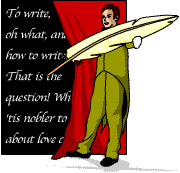Writing Right with Dmitri - How to Build a Character Who Doesn't Fall Apart in Two Paragraphs
Created | Updated Sep 1, 2011
Words, words, words. That's what we're made of. Herewith some of my thoughts on what we're doing with them.
Writing Right with Dmitri: How to Build a Character Who Doesn't Fall Apart in Two Paragraphs

Disclaimer from the start: I stole that title. Philip K Dick's seminal speech was called 'How to Build a Universe That Doesn’t Fall Apart Two Days Later'. I try to learn from the best – and so should you, which is why the blue text is there. What Dick was concerned with was the nature of reality. I'm going to save that topic for later, and talk about something Dick also touched on in his 1978 talk, which is how to build a character. I'm going to be 'how-to' and doctrinaire about it, not because that's the way I feel, but just to cut through the verbiage and give us something quick and direct to focus on.
The reason I'm focusing on character right now, rather than Dick's question of whether time is real, or the Goths/angels/angelic dinosaurs are having a laugh at our expense, is that before we can find out, we need to make up some cool characters. Once we find out what the characters do, we can start 'interrogating' them to find out what they're thinking. (You can't waterboard fictional characters – at least, not unless you write them into Gitmo first.)
Here, I think, are some basic don'ts to watch out for when creating a believable fictional character:
- Don't start with villains. No matter how clever you think it's going to be to make your main character a Baddy, stop. You will invariably paste him or her together out of all the traits that irritate you in the supermarket or at the office. Readers will notice this. Then you'll either over-identify with the character, and spend your time trying to justify behaviour you don't approve of, or you'll trash him soundly. Straw men don't make for good fiction1.
- Don't make your character too good. Just as you don't want to make your character a Snidely Whiplash, don't try for Miss Goody Two-Shoes. In the first place, there's no such animal. In the second place, you'll end up falsifying the character's experience to make him look better. Have your character look around: If everybody else in the room looks shabby next to him, try again.
- Don't warp the space around your character. I don't know if you like Agatha Christie or not, and I don't care. But don't create characters like that nasty little Belgian. If the IQ of everybody else in the room goes down 10 points when your character heaves in sight, you're trying to make him smarter than you know how. So cut it out.
Now a couple of do's:
- Do make your character consistent. It's okay if he hates broccoli. Don't let him eat it three scenes later. (Work out what happens when his mom tries to feed it to him. Work out what happens when he's the President and they try to feed it to him on Air Force One. Oh, wait. That's already happened.)
- Do make your characters out of people and ideas you know about. Sure, your character is Captain Marvellous of the Galactic Space Fleet. He still puts his trousers on one leg at a time. (If he has more than two legs, it just takes longer.) What does he think while he's shaving at the beginning of his diurnal anomaly? (See, you know that one.)
- Decide you're on the guy's side. Even if you have to kill him off. Killing him should be a painful process for you. That way, it will be a painful (and educational) process for the reader, as well.
- Stay on your character's side, even if everybody hates him. I have a character whose name is Robert Thigpen. Contrary to what some people may think, the only things we have in common are residence in North Carolina, small-dog ownership, and a certain degree of being vertically challenged. At least six people on this site have expressed an intense desire to bop Robert Thigpen in the jaw. In spite of this, I continue writing about him. He goes interesting places, like the Forlorn Hope Shopping Plaza in Acme.
- Finally, hope your characters hang around. If you don't kill them off, they might come back (like Dracula) and show you more things. Dickens used to complain that his characters argued with him all the time. He had to tell them to shut up in church. What this teaches us (besides the fact that Dickens wore a size eight tinfoil hat) is that characters will tell you want they want – if you just listen. Listening is an important, but often unregarded, part of the writing process.
So now I'll shut up for the week, and go away. I think Robert Thigpen's found something to do in Acme.
Happy writing!
